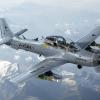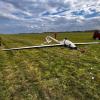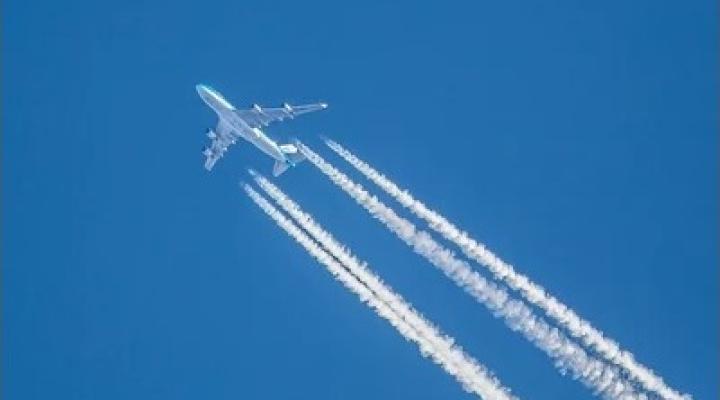ANA B788 near Takamatsu on Jan 16th 2013, battery problem and burning smell on board (including JAL Boston, Ethiopian London and
An ANA All Nippon Airways Boeing 787-800, registration JA804A performing flight NH-692 from Ube to Tokyo Haneda (Japan) with 129 passengers and 8 crew, was climbing through FL330 out of Ube about 35nm west of Takamatsu (Japan) when the crew received indications of battery problems, at the same time a burning smell developed on board. The crew decided to divert to Takamatsu where the aircraft landed about 14 minutes later. The aircraft vacated the runway, stopped past the hold short line and was evacuated via slides. One passenger received a serious, two passengers minor injuries during the evacuation.
All Nippon Airways and Japan Airlines have grounded their Dreamliners as result of the recent inflight incidents, see Incident: United B788 near New Orleans on Dec 4th 2012, electrical problems causing concerns of electrical heat on board, Incident: Qatar B788 near Doha on Dec 8th 2012, generator failure as well as an APU battery fire that occurred on board of Boeing 787-800 at Boston,MA (USA) on Jan 7th 2013.
The airline reported the crew received a fault indication within the battery system followed by a smoke detector indication inside one of the electrical compartments, there was no smoke visible in cockpit or cabin. The battery, same type as the one involved in the ground incident in Boston on Jan 7th 2013, was found discoloured and leaking, the battery obviously had developed high temperatures.
Japan's Tranportation Safety Board JTSB opened an investigation and dispatched three investigators on site. The NTSB dispatched an accredited representative to Japan to join the investigation.
The JTSB reported on Jan 17th 2013, that the crew received indication of a battery malfunction while climbing through FL300, in addition an odour occurred on board. The crew diverted to Takamatsu as a result, the aircraft was evacuated via slides after landing. The occurrence was rated a serious incident.
On Jan 23rd 2013 the JTSB released a preliminary report in Japanese reporting that a passenger received a sprained wrist and two other passengers minor injuries in the evacuation. The aircraft had been climbing through FL320 out of Ube when the crew received indication of failure of the battery and an odour appeared in the cockpit. Due to the odour the crew decided to divert to Takamatsu, where the crew landed on runway 26, vacated the runway onto taxiway T4 and initiated an emergency evacuation. Attending emergency services found no trace of fire, however traces of smoke released from the electric compartment were found on the outside of the fuselage. Investigators found the main battery, a lithium ion battery same type as the APU battery, had buckled at the upper cover and was leaking, the inside showed hydrocarbons. The main battery was removed from the aircraft on Jan 17th, the undamaged APU battery was removed from the aircraft on Jan 18th, following a first examination of the main battery on Jan 20th the battery has been dispatched for detailed examination on Jan 22nd.
On Feb 5th 2013 the JTSB released a second progress report in Japanese reporting that all 8 cells of the damaged battery, nominal voltage 29.6V, 75 Ah capacity at 28.5kg/63 lbs, showed thermal damage before the thermal runaway, particularly cells 3 and 6 are damaged. The positive electrode of cell 3 shows substantial damage and a hole, the internal wiring has melted down.
On Feb 20th 2013 the JTSB released another progress report in Japanese reporting, that the aircraft had no history of being hit by lightning. The positive electrode of cell number 3 had become so hot, that the material melted, the positive terminal of cells 1, 2, 6, 7 and 8 were damaged supposedly because of reaching the melting point of the terminal's material aluminium. The grounding wire of the battery container was broken most likely because of currents flowing through the container. The flight data recorder revealed that the battery voltage reduced from 31V to 11V within 10 seconds followed by voltage drops of about 1V every two seconds, prior to that a measured voltage of 32V indicated the battery was at nearly full charge. The investigation of why the voltage drops occurred is still underway, specific attention is given to the strobe navigation lights however, that were turned on during the encounter. The investigation is ongoing.
On Mar 27th 2013 the JTSB released another interim report in Japanese summarizing, that a "smoking gun" has still not been identified, the investigation so far has not yet led to "elucidation of the underlying cause". The JTSB reported that the puzzle about the navigation strobe lights has been solved however (see sketch below), with both APU and main batteries showing balanced voltages neither relay would be powered with the related switches off, however, with the main battery's voltage dropping to 1V a current flow from the APU battery via both relays to ground became possible, both relays activated and the wing tip and strobe lights activated despite being switched off. The wire connecting the battery case to ground was broken and showed evidence of having been blown (editorial note: implicitely suggesting prior to the battery event), however, the aircraft had no history of a lightning strike. There is no evidence, that battery charger, bus power control unit, generator control unit or battery diode module did not perform to specifications. Battery cells 1-8, especially 3 and 6, showed extensive internal damage, there is no evidence that a large current flow occurred on the output of the battery towards the hot battery bus.
The NTSB is currently investigating the APU battery fire that occurred on board of JAL Japan Airlines' Boeing 787-800 registration JA829J in Boston on Jan 7th 2013 after the passengers and crew had disembarked at the gate. The NTSB reported on Jan 20th 2013 that a first examination of the flight data recorder of JA829J showed the nominal battery voltage of 32V has never been exceeded. The battery, powering the APU for APU startup, has been disassembled into its 8 cells for detailed examination and documentation, 3 of the cells were selected for further disassembly and examination of cell internal components. On Jan 24th 2013 the NTSB reported that examinations including CT scans identified traces of electric short circuiting on an electrode (see photo below) as well as signs of thermal runaway on JA829J's APU battery. There was fire present.
On Feb 7th 2013 the NTSB reported: "After an exhaustive examination of the JAL lithium-ion battery, which was comprised of eight individual cells, investigators determined that the majority of evidence from the flight data recorder and both thermal and mechanical damage pointed to an initiating event in a single cell. That cell showed multiple signs of short circuiting, leading to a thermal runaway condition, which then cascaded to other cells. Charred battery components indicated that the temperature inside the battery case exceeded 500 degrees Fahrenheit." Mechanical impact damage as well as external short circuiting have been ruled out as causes, deformations and arcing were the result of a battery malfunction. The NTSB continued that Boeing conducted a risk assessment during the certification process which did not identify any possibility of a cell to cell propagation or of fire, both of which however occurred in the battery fire events at Boston. Boeing further assessed that a smoke release event would occur one time in 10 million flight hours, however, the two events at Boston and Takamatsu bring the balance to two events in 100,000 flight hours well above the failure rate predicted in the certification process. The NTSB concluded: "the possibility that a short circuit in a single cell could propagate to adjacent cells and result in smoke and fire must be reconsidered."
On Mar 7th 2013 the NTSB released an interim report reporting the APU of JA829J (169 flight hours/22 flight cycles since new) had been started at 15:04Z while the aircraft was taxiing to the gate. The aircraft reached the gate at 15:06Z, the passengers disembarked by 15:15Z and the crew left at 15:20Z. Cleaning personal entered the cabin. According to the flight data recorder the voltage of the APU battery, a Lithium Cobalt based battery rated at 75Ah/29.6V capable of delivering up to 1000A and typically 450A over 45 seconds for up to three APU start attempts, began to fluctuate at 15:21:01Z, failed at 15:21:15Z with the voltage dropping and reached 28V at 15:21:30Z. At 15:21:37Z the APU automatically shut down, the battery voltage reached 0V. A mechanic in the aft cabin noticed the power had been lost and went to the cockpit, recognized the APU had automatically shut down and went back to the aft cabin but smelled and saw smoke and notified the maintenance manger, who in turn asked the mechanic to check the aft electronic bay. The mechanic found heavy smoke and observed two distinct flames of about 3 inches at the APU battery. The mechanic attempted to extinguish the fire using a dry chemical fire extinguisher but flames and smoke did not stop. At 15:37Z emergency services were alerted, the first vehicle arrived less than a minute later. Multiple attempts by emergency services to extinguish the fire were unsuccessful, the battery appeared to rekindle. A pop sound was heard followed by hissing sounds, a firefighter received a minor burn at the neck when the battery popped. It was decided to remove the battery, about 80 minutes after the begin of the event the battery was moved out of the aircraft, 100 minutes after the begin of the event the situation was pronounced under control. The battery had weighed 61.8lbs/28kg when it was installed and weighed 56 lbs/25kg when it was removed from the aircraft mainly due to the loss of electrolyte. Examination of the cells and battery revealed a number of protusions on cell 5, which were determined to the result of arcing between between the cell 5 case and battery case, the protusions were outward and the cell case had expanded outward, the arcing was the result of the cell expansion leading to the breach of the battery case. Tests of the battery monitoring unit were not possible due to the damage received during the fire, the battery control unit passed all tests (except that it inhibited charging already above the permitted minimum temperature of 5 degrees F). Boeing had assessed the risk of a battery cell venting at one in 10 million flight hours and the risk of the battery spilling flammable fluid at one in 1 billion flight hours, however, only 52,000 flight hours had been accumulated in operation of the B787 so far and two batteries had vented/spilled. The only scenario, that Boeing had identified, that could lead to the battery venting with fire was overcharge, the design requirements made it highly improbable that an overcharge could occur. The investigation is continuing.
The incidents prompted the FAA to conduct a review of the Boeing 787 design, manufacturing and quality assurance processes, the US Department of Transport and the FAA are convinced, that the aircraft is safe reporting they spent more than 200,000 man hours during certification of the aircraft.
In the evening of Jan 16th 2013 the FAA released an emergency airworthiness directive requiring all operators of Boeing 787-800 with immediate effect to modify the battery system or take another FAA approved action before further flights, which effectively grounds the aircraft. The FAA argued: "This emergency AD was prompted by recent incidents involving lithium ion battery failures that resulted in release of flammable electrolytes, heat damage, and smoke on two Model 787-8 airplanes. The cause of these failures is currently under investigation. These conditions, if not corrected, could result in damage to critical systems and structures, and the potential for fire in the electrical compartment."
On Mar 12th 2013 the FAA announced they approved a plan to certificate an improved battery system provided by Boeing. An improved containment of the battery, and improved venting system, a redesign of battery components to reduce the risk of short circuits inside the battery and better insulation of cells are parts of that plan, the FAA has also approved limited test flights to two Boeing 787-800s, the FAA said: "The purpose of the flight tests will be to validate the aircraft instrumentation for the battery and battery enclosure testing in addition to product improvements for other systems." The AD remains in effect until the tests conclude successfully, the FAA did not provide any estimates on the time line.
On Apr 26th 2013 the FAA released a new airworthiness directive 2013-08-12 superseding the emergency airworthiness directive of Jan 16th 2013 permitting the Boeing 787-800 to resume service after following steps have been taken: "Install main battery and auxiliary power unit (APU) battery enclosures and environmental control system (ECS) ducts; and replace the main battery, APU battery, and their respective battery chargers; in accordance with the Accomplishment Instructions of Boeing Alert Service Bulletin B787-81205-SB500003-00, Issue 001, dated April 19, 2013." As result of this new airworthiness directive a first Boeing 787-800 registration ET-AOP of Ethiopian Airlines took the skies on Apr 27th 2013 flying passengers from Addis Ababa (Ethiopia) to Nairobi (Kenya) as flight ET-801.
On Jul 12th 2013 an Ethiopian Airlines Boeing 787-800 registration ET-AOP was parked at London Heathrow Airport with no occupants, when smoke began to billow from the rear of the aircraft prompting emergency services to respond and both runways to be closed. The aircraft was foamed and the fire extinguished. The cause of the fire is unknown at this time. The aircraft had arrived in Heathrow as flight ET-700 at 06:30L (05:30Z) and was scheduled to depart for the return flight ET-701 at 21:00L (20:00Z). On Jul 13th 2013 the AAIB reported that there had been smoke throughout the fuselage causing extensive heat damage in the upper portion of the rear of the fuselage and stated: "However, it is clear that this heat damage is remote from the area in which the aircraft main and APU (Auxiliary Power Unit) batteries are located, and, at this stage, there is no evidence of a direct causal relationship."
On Jul 18th 2013 the AAIB reported in their special bulletin with respect to ET-AOP, that fire fighters encountered a fire above the ceiling panels close to the rear of the cabin, a halon extinguisher was not effective, only after a panel was moved and the fire was doused with water and foam the fire was extinguished. The origin of the fire coincided with the emergency locator transmitter (ELT), with no other systems in the vicinity storing sufficient energy to initiate a fire. The ELT is powered by a set of Lithium Manganese Dioxide Batteries, which showed disruptions of cells. It is unclear however whether the combustion started as result of energy release within the battery cells or by an outside event like a short circuit. Some 6000 units of this transmitter have been produced, ET-AOP is the only such incident so far. The AAIB recommended to the FAA to "inert" (deactivate) the ELTs in Boeing 787s until appropriate airworthiness actions can be taken and to conduct a safety review of all Lithium battery powered ELTs on all aircraft types.
On Jan 14th 2014 a JAL Japan Airlines Boeing 787-800, registration JA822J, was parked at the apron of Tokyo's Narita airport and was being prepared for departure for flight JL-707 to Bangkok (Thailand) scheduled about two hours later, when white smoke was observed from the aircraft's main battery, the battery was found overheated, its safety valve opened and electrolyte fluid leaking from the battery. No further damage is being reported, the aircraft was removed from service. A replacement Boeing 787-800 registration JA829J operated the flight departing with a delay of 7 minutes and arriving on schedule. Boeing tweeted that the aircraft was in maintenance, a single cell vented resulting in a smoke event, the new safe guards worked as planned. The battery suffered a fault in the charger and battery. The airline stated: "A maintenance personnel in the cockpit found that the white smoke was wafting outside of the window and that the message which indicated the possibility of main battery system failure was displayed on the cockpit display during departure preparation. The inspection of the battery case inside the battery enclosure revealed that the safety pressure relief valve (which opens in case that the cell inside pressure rises) of one cell of the eight cells opened. JAL707 departed by another Boeing 787 almost on time." This new ground incident comes a few days after both NTSB and JTSB announced the investigations into the thermal runaways of the APU and main battery in Takamatsu and Boston have been finished and the final reports are being prepared for release later in 2014.
Schematics of battery and damage of ANA main battery (Graphics: AVH/JTSB):
The grounding wire of battery case (Graphics: JTSB):
The electrical path activating wing tip lights despite switched off (Graphics: JTSB):
Battery diagram (Graphics: NTSB):
The damaged electrode of cell 3 (Photo: JTSB):
Traces of smoke exiting the fuselage (Photo/Graphics: JTSB):
Main battery left, undamaged APU battery right (Photos: JTSB):
Hole in an electrode of JA829J indicative of short circuit (Photo: NTSB):
The burned battery of JA829J, Boston Jan 7th 2013 (Photo: NTSB):
http://avherald.com/h?article=45c377c5














Komentarze